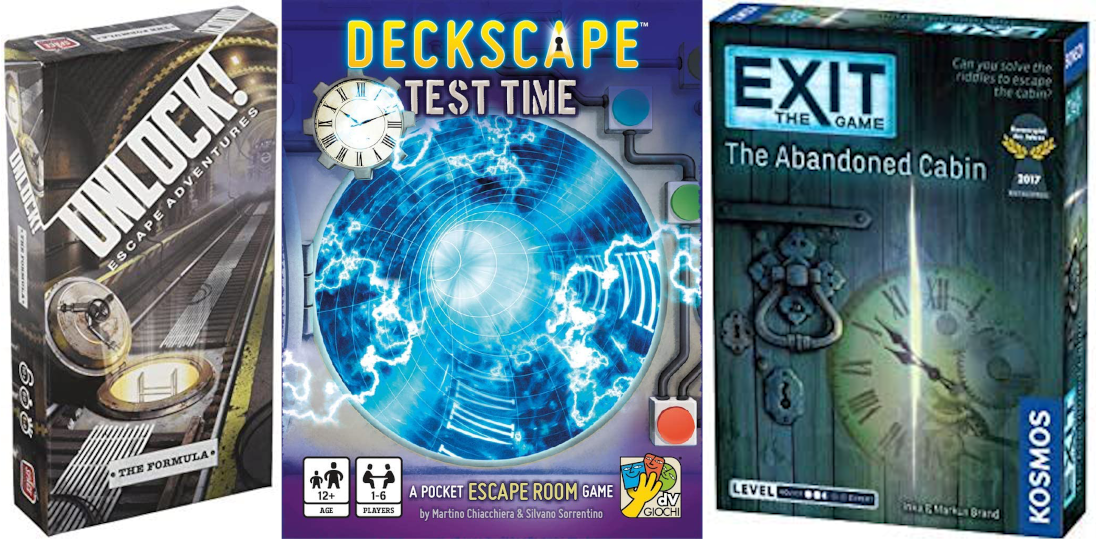
Even before the COVID-19 lockdown, my family and I enjoyed doing escape rooms. We are lucky enough to be a place with easy access to commercial escape rooms like Escapology Live Escape Games - Worldwide Escape Rooms, plus a few other smaller ones. However, we are not master puzzle breakers. Our track record for solving the puzzles is rather low. Still, the experience of doing escape rooms is so enjoyable for all involved the a string of loses, though galling, is not a deal-breaker.
We are a natural market for “board game” versions of escape rooms and we have going through at least three of the following titles: Exit: The Game, Unlock!, and Deckscape. In this post, I would like to offer my impressions of each system and its suitability to casual family gaming.
I will forego any pseudo-scientific rating system, but instead lay bare my biases. Each system has been judged by my experience playing the game with three people, one of which is a pre-teen. How well each delivered a memorable and pleasant gaming experience is my primary criterion.
One last note: my family does not play with timers. These introduce FAR TOO MUCH drama into a process that is sufficiently fraught for the players. If you too are looking for casual fun, do discard any timing device. The game ends when the last puzzle is solved or your players are uninterested in continuing.
DECKSCAPE
Deckscape, as the name suggests, is merely a deck a cards! Puzzles are both visually based (meaning you have to find hidden figures in cards), and logic based. No additional device is needed.
By far, this is the best series for casual escape room fun. No, these games will not impress you hard-core gamer friends, but they are all replayable and the stakes never feel too high. Aside from logic and math, you rarely need any outside knowledge to complete the puzzles. I only wish there were more of these!
The only drawback to this system is the lack of an in-game hint system. However, I don’t find these puzzles rarely necessitate them.
Great starter titles from this series: Test Time and The Fate of London.
UNLOCK!
These games require a tablet or mobile device to play. It is possible to disable the timer for most of these games, although a few specific titles do have timed events (like Tombstone Express and The Nautilus’ Traps), and I do not recommend those specifically.
My family has had the best luck with this series. There are many titles to choose from, with a variety of fantasy settings that should appeal to many. Some real-world knowledge (especially for the Arabian Nights themed title) are very helpful for solving the puzzles. This is not typically the case.
The app has a hint system, which works well. Some of the “figure out the weird device” type puzzles are less interesting to me, but I know these appeal to some (as this kind of thing is all over Interactive Fiction games).
Great starter titles from this series: The House on the Hill and The Formula.
EXIT
The Exit series has the most of titles of any of the offerings mentioned in this post. Each title has self-contained game that is card-based with additional custom “feelies” and make this series extremely popular. The system consists a riddle deck, a solutions deck, and a hints deck. There are 10 puzzles per game. Puzzles are visual, logical, spatial, and may require some crafting skills, like precision cutting and measuring. By far, this series has the most creative puzzles and the most unique puzzle solving experiences. Why is this not my favorite series?
Although we have done 3-4 of titles in Exit, we have never completed any title. We always quit before the end. Frequently, we get dead-ended in the game, where is it unclear what the puzzle is. In the last on we did, we got to a point where we need a “hidden feelies” to solve the puzzle, but we were never told by the game to obtain that. We just took the the thing anyway and moved on.
Many of the puzzles require more careful crafting of cards or feelies items than my family (or me) is interested in doing. I’m not terrible with rotating objects in my head, but I am terrible at crafting in general and worse doing so under pressure. When you are a parent, you cannot give any one task 100% of your attention, but the Exit series, which often has a lot of “game state” to manage requires this.
One last point, the production values of Exit games are very high. Each title is gorgeous. Although I find some of the puzzles rather opaque, I am inclined not to blame the game designers but my own limitations for this. I wish I could enjoy this series more.
Great starter titles from this series: The Abandoned Cabin. If you do not like this one, do not bother with the rest of the series.
Honorable Mention: Journal29
One last entry that I recommend as an excellent family activity is Journal 29, which is a book-based “escape room” or series of puzzles. The fiction of this is that a group of researchers working on a secret project have disappeared, leaving behind one last journal filled with clues to suggest the nature of their work and the reason for their disappearance. This will be very familiar to X-Files fans.
You do need an internet-enabled device to solve the puzzles, some of which require GPS look-ups, or special media files from journal29. Most of the puzzles are visual and logic based. Some may require light googling.
On the other hand, I found these puzzles incredibly approachable (4 out of some 60 utterly stumped me). Doing this puzzles with your family over the course of several sessions is very enjoyable.
I hope this helps you find the right escape room experience for your family. These games are a great way to keep your brain engaged while providing a unique (mostly non-digital) shared experience.

